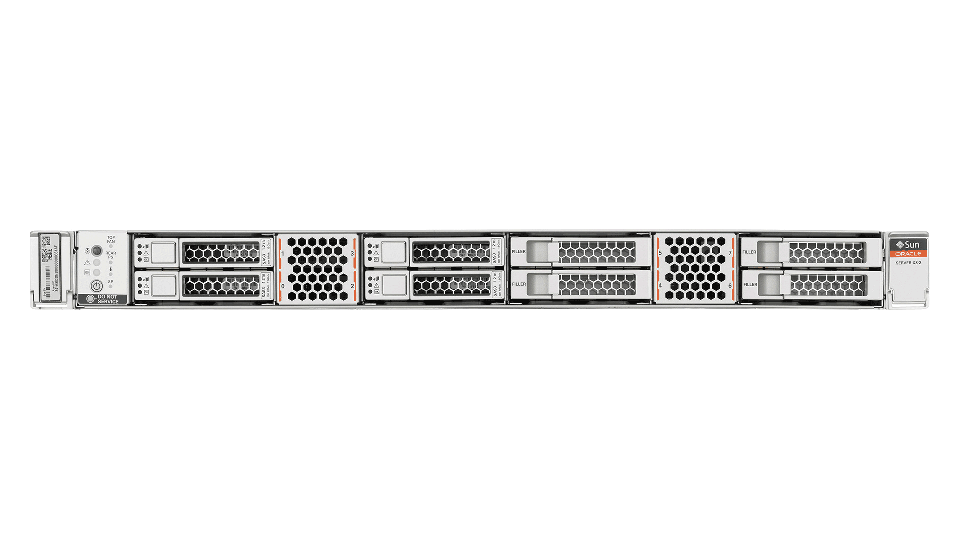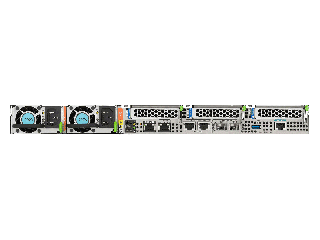Oracle Server X8-2
Designed to Run Oracle Database with Maximum Security, Reliability, and Performance
[7120204]Details
Compact and energy-efficient 1U enterprise-class server
Oracle Server X8-2 is engineered for running Oracle Database in deployments using SAN/NAS, and for delivering infrastructure as a service (IaaS) in cloud and virtualized environments that require an optimal balance among core density, memory footprint, and I/O bandwidth.
With support for up to 51.2 TB of high-bandwidth NVM Express (NVMe) flash drives, Oracle Server X8-2 can store either the entire Oracle Database in flash for extreme performance or accelerate I/O performance using Database Smart Flash Cache, a feature of Oracle Database. Each server includes built-in proactive fault detection and advanced diagnostics to deliver extreme reliability for Oracle applications.
With a compute capacity of over 2,000 cores and 64 TB of memory in a single rack, this compact 1U server is an ideal framework for standing up densityefficient compute infrastructure without compromising reliability, availability,and serviceability (RAS).
Performance Overview
Oracle Server X8-2 is a server which has 24 memory slots, is powered by two Platinum, or Gold, Intel® Xeon® Scalable Processor Second Generation CPUs.
With up to 24 cores per socket, this server delivers extreme compute density in a compact 1U enclosure. Oracle Server X8-2 provides the optimal balance of cores, memory, and I/O throughput for enterprise applications
Features
- Compact and energy-efficient 1U enterprise-class server
- Highest levels of security enabled out of the box
- Two Intel® Xeon® Scalable Processor Second Generation CPUs
- Twenty-four dual inline memory module (DIMM) slots with maximum memory of 1.5 TB
- Four PCIe Gen 3 slots plus two 10 GbE ports or two 25 GbE SFP ports
- Eight NVM Express (NVMe) SSDenabled drive bays, for high-bandwidth flash
Built for high performance IO
Built for the demands of enterprise and virtualization workloads, this server offers four PCIe 3.0 expansion slots (two 16-lane and two 8-lane slots). Each Oracle Server X8-2 includes eight small form factor drive bays. The server can be configured with up to 9.6 TB of hard disk drive (HDD) capacity or up to 6.4 TB of conventional solid-state drive(SSD) flash capacity. This system can be configured with up to eight 6.4 TB NVM Express SSDs, for a total capacity of 51.2 TB of low-latency, high-bandwidth flash. In addition, Oracle Server X8-2 supports 960 GB of optional on-board flash storage for OS boot.
With up to 156 GB/sec of bidirectional I/O bandwidth, combined with the high core and memory density, Oracle Server X8-2 is an ideal server for standing up enterprise applications in a virtual environment. With a standard, efficient power profile, Oracle Server X8-2 can be deployed easily into existing data centers as the building block of a private cloud or IaaS implementation./p>
Designed for Oracle Applications and Database
Designed as an optimal server for running Oracle Database with existing SAN/NAS storage solutions, customers can reap the benefits of Oracle’s investments in engineering Oracle Server X8-2 with Oracle’s operating systems and database. Oracle Server X8-2 systems can be combined with Oracle Real Application Clusters (Oracle RAC) to enable high availability and scalability. In order to achieve accelerated performance for Oracle Database, Oracle Server X8-2 uses hot-pluggable, highbandwidth flash that is engineered to work together with Oracle’s Database Smart Flash Cache.
Oracle Linux and Oracle Solaris running on Oracle Server X8-2 include RAS features that increase overall server uptime. Real-time monitoring of the health of the CPU, memory, and I/O subsystems, coupled with off lining capability of failed components, increases the system availability. These are driven by firmware-level problem detection capabilities that are engineered into Oracle Integrated Lights Out Manager (Oracle ILOM) and the operating systems. In addition, exhaustive system diagnostics and hardware-assisted error reporting and logging enable identification of failed components for ease of service.
Unmatched Security
Oracle Server X8-2 ships with the Oracle ILOM 4.0, a cloud-ready service processor designed for today's security challenges. Oracle ILOM provides real-time monitoring and management of all system and chassis functions as well as enables remote management of Oracle servers. Oracle ILOM uses advanced service processor hardware with built-in hardening and encryption as well as improved interfaces to reduce the attack surface and improve overall security.
Oracle ILOM has improved firmware image validation using improved firmware image signing. This mechanism provides silicon-anchored service processor firmware validation that cryptographically prevents malicious firmware from booting. After Oracle ILOM's boot code is validated by the hardware, a chain of trust allows each subsequent firmware component in the boot process to be validated. Finally, with a focus on security assurance, using secure coding and testing methodologies, Oracle is able to maximize firmware security by working to prevent and remediate vulnerabilities prior to release.
Unrivalled Support Frameworks
Oracle Premier Support customers have access to My Oracle Support and multi-server management tools in Oracle Enterprise Manager 13c. Oracle Enterprise Manager 13c, a critical component that enables application-to-disk system management, coordinates servers, virtual machines, storage, and networking for an IaaS solution complete with monitoring, provisioning, and metering.
Oracle Enterprise Manager 13c also features an automated service request capability, whereby potential issues are detected and reported to Oracle’s support center without user intervention, assuring the maximum service levels and simplified support.
| Part No. | 7120204 |
|---|---|
| Manufacturer | Oracle |
| End of Life? | No |
| Preceeded By | X7-2 |
| Rack Units | 1U |
| Height | 42.6 |
| Width | 436.5 |
| Depth | 737 |
| Weight [Kg] | 18.10 |
| CPU Socket(s) | 1 or 2 |
| Compatible CPU(s) | Intel® Xeon® Platinum 8260 processor: 2.4 GHz, 24 cores, 165 watts, XCC, 35.75MB L3 cache; Intel® Xeon® Gold 5218 processor: 2.3 GHz, 16 cores, 125 watts, XCC, 22 MB L3 cache; Intel® Xeon® Gold 5222 processor: 3.8 GHz, 4 cores, 105 watts, XCC, 16.50 MB L3cache |
| Max CPU Clk Spd | Up to 3.8 GHz |
| CPU Cache | Up to 35.75MB TLC |
| Max # Thread(s) | Up to 48 per socket |
| Max # Core(s) | Up to 24 per socket |
| Memory Slot(s) | 24 |
| Memory Capacity | Up to 1.5 TB of DDR4 ECC DIMM memory |
| Memory Expansion | RDIMM options: 16 GB at DDR4-2666 single rank and 32 GB at DDR4-2666 dual rank; LRDIMM option: 64 GB at DDR4-2666 dual rank |
| Drive Bays | Uses NVM Express (NVMe) design that allows for flash to be front accessible and hot swappable; Up to eight small form factor NVMe drives (6.4 TB per drive); |
| HDD Suitability | Eight 2.5-inch front hot-swappable disk bays; HDDs or conventional SSDs, or NVMe SSDs; |
| RAID Options | Optional: 12 Gb/sec SAS-3 RAID HBA supporting levels: 0, 1, 5, 6, 10, 50, and 60 with 2 GB of flash-backed write-back cache |
| Supported OS | Oracle Linux; Oracle Solaris; Oracle VM |
| USB Port(s) | USB: two 3.0 USB ports (one rear, one internal) |
| PCI Slot(s) | Expansion bus: four PCIe 3.0 slots: two x16 and two x8 (one internal) slots; Supports LP-PCIe cards including Ethernet, InfiniBand, FC, and SAS HBAs |
| LAN Socket(s) | Two 1/10 GbE ports (RJ45) or two 1/10/25 GbE ports (SFP28); Dedicated 10/100/1000 M Base-T network management port |


